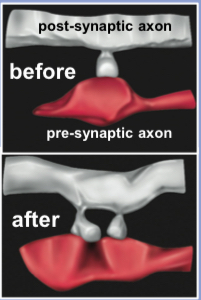Ch.12 Learning & Memory
1/30
There's no tags or description
Looks like no tags are added yet.
Name | Mastery | Learn | Test | Matching | Spaced |
|---|
No study sessions yet.
31 Terms
Where are memories stored in the brain
The terms ‘LEARNING AND MEMORY’ are so often paired that it sometimes seems as if one necessarily implies the other
We cannot be sure that learning has occurred unless a memory can be elicited later
Early studies by Lashley & Penfield attempted TO FIND A LOCUS FOR WHERE MEMORIES ARE SORED
Later research confirmed that memories are stored throughout the brain in a distributed fashion, wherever the events are processed
Amnesia
Many kinds of brain damage, caused by disease or accident, impair learning & memory by causing amnesia
AMNESIA is the loss of memory
ANTEROGRADE AMNESIA refers to the inability to form NEW MEMORIES AFTER THE EVENT that caused the amnesia
RETROGRADE AMNESIA refers to MEMORY LOSS FOR INFORMATION OCCURRING PRIOR TO THE EVENT that caused the amnesia
Studies of amnesia patients help to clarify the distinctions among different kinds of memories & their mechanisms
The Case History of HM
In 1953, a patient, named HM, underwent an experimental brain operation at the Hartford Hospital to relieve his seizure disorder
William Scoville was the surgeon, who was very much influenced by Penfield who had done similar surgeries
Immediately after the operation, HM showed a profound ANTEROGRADE AMNESIA
Hiss memory was “pure” & not accompanied by intellectual or personality disorders
To better understand the brain structures required for memory, HM became the topic of intense scientific study for more than five decades
Case of HM PT.2
The surgery was a bilateral temporal lobe resection, which included hippocampus, amygdala & some surrounding temporal cortex
After the surgery, he appeared NO LONGER ABLE TO ESTABLISH NEW MEMORIES for events in his everyday life or to learn new information
But HM was not completely devoid of all memory
In fact, his short term memory (ST) was good; and his long term memory (LTM) for childhood events was good
Role of Hippocampus in Memory
The HIPPOCAMPUS [and not the amygdala] was implicated in the HM because other surgical patients, who had bilateral damage to the amygdala, did not exhibit memory impairment
These findings suggested that the HIPPOCAMPUS MAY BE NECESSARY FOR FORMING NEW MEMORIES (i.e. consolidation)
Thus a massive effort was undertaken to understand the role of the hippocampus
Basic Memory Processes
Since the case of HM, studies have show that a functional memory system must incorporate 3 stages of information processing:
ENCODING of raw information from sensory channels into STM
CONSOLODATION/STORAGE of STM traces into a more durable from of memory called LTM
RETRIEVAL of stored information for use in future behavior
Note: a problem with any of these memory processes will lead to FORGETTING
Ex:
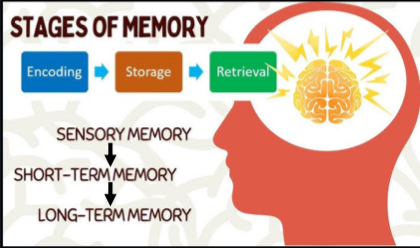
Long Term Memory
Dr. Brenda Milner, a pioneer in the field of neuropsychology, who worked with Penfield, came to study HM
On the basis of her assessments of HM, she was able to demonstrate that LTM was comprised of two different memory systems
1) DECLARATIVE (explicit) memory: refers to facts & info acquired through learning
We are aware of this information & we can declare or verbalize it to others — this memory deals with “what”
2) NON-DECLARATIVE (implicit or procedural memory): is memory about perceptual or motor procedures, demonstrated by performance rather than by conscious recollection — this memory deals with “how”
The job of the HIPPOCAMPUS is to serve MEMORY CONSOLIDATION for declarative LTM… but info is actually not stored in the hippocampus
Types of Declarative & Non-declarative LTM
There are two from of DECLARATIVE MEMORY:
EPISODIC MEMORY
Recalling a specific episode from your life
SEMANTIC MEMORY
Is knowing the meaning of a word without knowing where or when you learned the word
There are three forms of NON-DECLARATIVE MEMORY
SKILL LEARNING
learning to perform a series of procedures that requires motor coordination
PRIMING (repetition priming)
Exposure to a stimulus facilitates or speeds subsequent responses to the same/similar stimulus
CONDITIONING
Learning simple associations between two stimuli, or a stimulus with a response
Key Learning Theorists
Pavlov, Skinner, Watson
Two learning theories:
Classical conditioning & operant conditioning
Both use nondeclarative memory
Pavlov: Classical Conditioning
Pavlov won Nobel prize in 1904 for his work on the physiology of digestion
Discovered CLASSICAL CONDITIONING in which the pair ring of 2 stimuli changed the response to one of them
an UNCONDITIONED STIMULUS (UCS) automatically results in an UNCONDITIONED RESPONSE (UCR)
After several pairing of the CONDITIONED STIMULUS (CS) with the UCS, the CONDITIONED RESPONSE (CR) can be elicited by the CS without the UCS being presented
Ex:

Watson & Skinner: Operant Conditioning
In OPERANT CONDITIONING, responses are followed by reinforcement or punishment that either strengthen or weaken the probability that the behavior will occur in the future
POSITIVE & NEGATIVE REINFORCERS are events that increase the probability that the response will occur again
PUNISHMENTS are events that decrease the probability that the response will occur again
Ex:
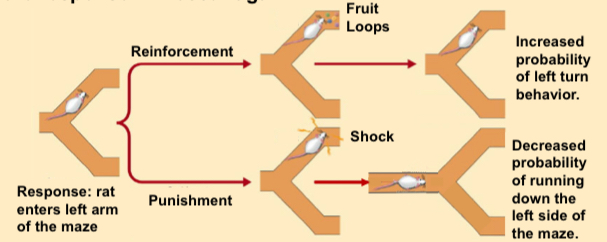
Memory Diagram
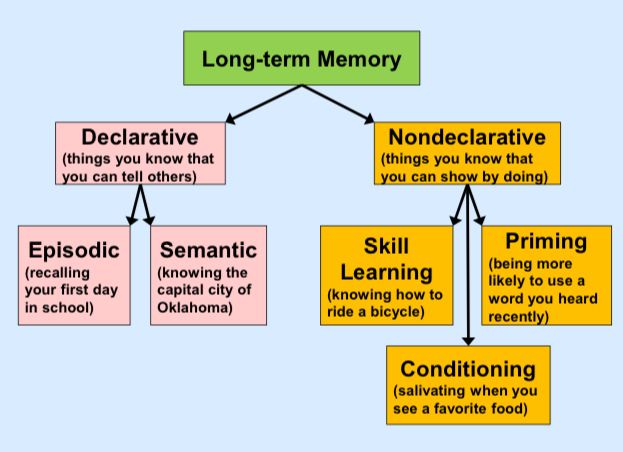
Ex of skill learning & non-declarative LTM
Mirror tracing task
Trace a figure with a styles, but can only see the mirror reflection
With practice, persons trace the figure more quickly & make fewer errors (departures from the figure)
Persons with deficits in nondeclarative LTM willl be unable to show improvement with practice
But Milner found that HM showed progressive task improvement
She concluded that his non-declarative LTM was intact; thus, HM ONLY HAD A DEFICIT IN DECLARATIVE LTM
Hebb’s Theory of Memory
Herb (1949) hypothesized that memory has temporal stages
Sensory memory
short-term memory
long-term memory
The AMOUNT OF TIME that info will be retained & the AMOUNT OF INFO that can be stored varies among the different categories for memory
Sensory Memory
Briefest memories are called ICONIC MEMORIES (visual) & ECHOIC MEMORIES (auditory)
Fleeting impressions that vanish in <1sec
Thought to be residual sensory perceptions
Short-Term Memory (STM)
If attention is paid to the elements in sensory register, STM retains the info for less than 1 minute
You can retain 7 ± 2 items in STM
Repetition keeps the info available longer
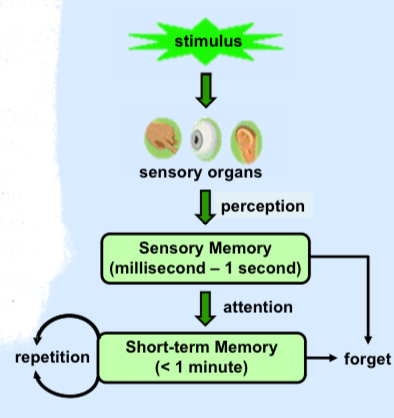
Long-term Memory (LTM)
enduring from of memory that lasts days or longer, with very large capacity
Memory Trace
A persistent change in the brain that reflects the storage of info
Hebb Theory Around Long-Term Memory
Neuronal activities continue even after the termination of the stimulus → inducing STRUCTURAL CHANGES
Different neurons are linked via this activity & form neural circuits that can fire in specific patterns with minimal stimulation
Workin memory (Central Executive)
Is responsible for the transient holding & processing of new & already stored information; integral for reasoning, comprehension, and learning memory

Hippocampus: Context
Hippocampus is involved in cognitive processing of space, time, & the relationships of external cues occurring at the time of an event… CONTEXTUAL LEARNING
I.e., remembering the detail & context of an event
Hippocampus: Spatial Mapping & Navigation
Hippocampal pyramidal neurons recorded exploring an open space exhibit “BORDER, PLACE & GRID FIELDS”
These cells serve to generate a mental representation of the spatial layout of an environment, known as a COGNITIVE MAP
BORDER OR BOUNDARY CELLS fire when a person is located near the geographic limit of the space they are in
PLACE CELLS fire when a person occupies a particular location relative to the arrangement of object within an environment
GRID CELLS fire when a person is in, or moving toward, a location
Figure Depicting Functional Maps of Hippocampus
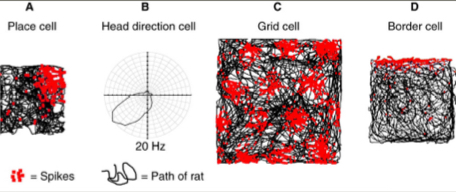
Other Cortical & Subcortical Areas Involved in Learning & Memory
Prefrontal Cortex & Anterior Cingulate Cortex
Parietal lobe 2^O cortex
Anterior & Inferior Region of the Temporal Cortex
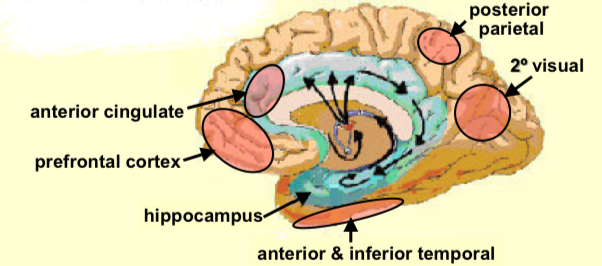
Prefrontal Cortex & Anterior Cingulate Cortex
Are linked with learning about rewards & punishments
Parietal lobe 2^O cortex
Associated with the piecing sensory (e.g., 2^O visual) & motor information together (e.g., dorsal pathway)
Anterior & Inferior Region of the Temporal Cortex
Is associated with semantic memory (meaning of words) & object recognition (e.g., ventral pathway)
The Neural Basis of Learning in the Nervous System
ERIC KANDEL
Won the 2000 Nobel prize in physiology or medicine for his 1960-80’s research on the physiological basis of memory in storage neurons
Studied 3 forms of learning
Habituation
Sensitization
Classical Conditioning
APLYSIA:
Kandel studied the gill & siphon withdrawal reflexes because of the simplicity & relatively large size of the neural circuitry
Results: provided solid evidence for the mechanistic basis of learning as “a change in the functional effectiveness of previously existing excitatory connections
In learning, a HEBBIAN SYNAPSE occurs when:
The successful stimulation of a cell by axon leads to the enhanced ability to stimulate the cell in the future
The Neural Basis of learning in the Nervous System (Chemical Explanation)
Biochemical mechanisms of LTP are known to depend on changes at GLUTAMATE RECEPTORS (AMPA & NMDA) primarily in the postsynaptic neuron
Adjacent to the AMPA receptors, magnesium (Mg) ions normally block the NMDA receptors
Repeated glutamate excitation of AMPA receptors depolarizes the membrane (Na+ enters)
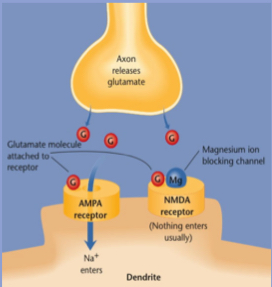
The Neural Basis of learning in the Nervous System (Chemical Explanation) Pt. 2
Right panel: The depolarizationat the AMPA channels displaces the Mg ions from blocking the NMDA receptors
Glutamate is then able to excite the NMDA receptors, opening a channel for Ca+++ & Na+ ions to enter the neuron
Repeated Ca+++ entry though the NMDA channel triggers protein synthesis that induces production of more AMPA & NMDA receptors
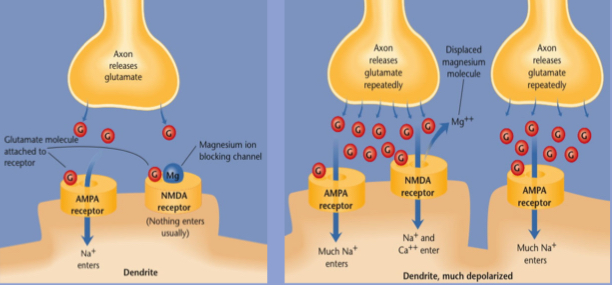
In sum, learning & memory involves tow things:
SHORT-TERM changes:
Decreased action potential threshold
Increased neurotransmitter release
Increased number of receptors (LTP)
LONG-TERM CHANGES:
Collateral sprouting & axonal branching to increase number of synapses
